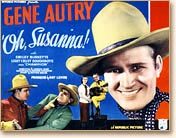September 8 歌うカウボーイの「おおスザンナ」 (1936) Oh, Susanna! (1936) by the Singing Cowboy [スザンナ周辺]
September 08, 2008 (Tuesday)
from "Film Info - Oh, Susannna!" GeneAutry.com
歌うカウボーイといえば、ジーン・オートリーである。英語版Wikipedia の "Singing cowboy" の項目は、歌うカウボーイの系譜の最初に ジョン・ウェインを置いてますけど、Gene Autry (1907-98) と Roy Rogers (1911-98) です。ロイ・ロジャーズはオートリーの映画会社との契約がこじれたときにピンチヒッター的に出て、あとを継ぐかたちで1940年代に人気者になるわけですけど、第一人者はジーン・オートリーだったのだと思います。オートリーの初期の映画に『おおスザンナ Oh, Susanna』 (1936) があって、これがシンギング・カウボーイの一番だと話はたいへん気持ち悪いくらいに美しいわけですけど、そうではありません。1935年の Melody Trail が最初のようです(くわしいフィルモグラフィーは、たとえばInternet Movie Database のGene Autry のページ)。そして、1936年初頭のオートリー主演の映画のタイトルが Singing Cowboy でした。そしてさらにそれから5作目、第1作から勘定すると10作目が(といっても2年目ですけど)Oh, Susanna! でした。
歌うカウボーイについては、文章の執筆者と典拠が不明ですが、 「カウボーイアーティスト」と題する「goo 音楽」のページの記述をあえて引いておきたいと思います。――
カウボーイとは
19世紀――牛を追って長い道のりを移動しながら生活していたカウボーイは、夜になると牛たちを落ち着かせるかのように 歌っていた。トレイルを進みながら、あるいはキャンプファイアを囲みながら、長い夜の退屈しのぎに自分自身や仲間たちのために歌っていたのだ。 「Streets of Laredo」「The Dying Cowboy」のような定番のカウボーイ・ソングは今世紀に入ってからのものだが、実際は何世紀も前にアングロサクソンが歌っていた民謡の亡霊なのだ。ア メリカ人のカウボーイへの憧れと西部開拓の夢のお陰で、カウボーイたちの歌は1920年、30年代には流行の的となった。Carl Spragueのような初期のアーティストはかなり伝統的なスタイルだが、the Sons of the Pioneers やGene Autryのような後発アーティストは、キャンプファイアでの定番ソングをポップ・ソングに変えたのだ。1930年代に音声映画が始まると、歌うカウボーイたちは銀幕を走り抜けながら、より有名な存在になっていった。その中には女性も数人いて、最も有名なのは「I Want to be a Cowboy's Sweetheart」を歌ったPatsy Montanaであった。しかしながら、現在のカウボーイのトレンドは、Riders in the Skyのようなリバイバル・グループによってかすかに伝承されている、という状況だ。
英語の記述としては、 Lillian Turner の "The Singing Cowboys: Real to Reel" という文章をいちばん下に引いておきます。
で、シンギング・カウボーイ映画というのはウェスタンのミュージカル版という言い方もされるかもしれませんけど、それほど不自然に音楽がちりばめられていたりキャラクターが歌にあわせて踊りだすく(田森がいやがるようなかたちで)わけでもなく、わが小林旭のギターを抱いた渡り鳥シリーズの原型といった方がわかりやすいし近いのではないかと思います。
物語のプロットとしては、あるコミュニティーによそ者としてやってきた主人公が、コミュニティーの人間関係を正し悪を解決してまた旅の空に去っていく、というような水戸黄門、シェーン・カム・バック的なロマンス系のようです。むろんそれ自体が西部劇のプロットであり、原型をたどるとジェームズ・フェニモア・クーパーの『皮脚絆物語 Leatherstocking Tales 』シリーズのナッティー・バンポーという、アメリカ人に訴える男の理想型ということになります。クーパーで考えると、男女のロマンスがメインのプロットだったり、土地争いがプロットだったり、戦争がプロットだったりして、そこにワキからからんでくる比較的マージナルな位置にいるキャラクター。(これは、一度いた土地に戻ってきて新たな問題を解決する、というような変形をすると、モーリちゃんの父の好きな昭和残侠伝などのやくざ映画のパタンになります、たぶん。)
1936年の『おお、スザンナ!』 は、59分という短い映画で、たいへん凝縮されたかたちで物語が展開します(特に冒頭はすごい濃度。ま、わざわざ帽子をかぶらせて汽車からほっぽるところが不自然ですけどw)。――
"Oh, Susanna! 1/8 (1936)" posted by hollywoodclassics5 on July 29, 2008: "Fleeing the law, Wolf Benson hops on a train, throws Autry off, and assumes Autry's identity. Still posing as Autry he robs and kills Autry's friend Lee. When Autry is jailed, his friends Frog and the Professor break him out and the three head out to clear him of the murder charge."
最初はオープニングと冒頭近くのBGM だけなのですけれど、「おおスザンナ」を歌うシーンも出てきます。短いですし、オートリーじゃないですけど(2:30ぐらいのところから)――
"Oh, Susanna! 5/8 (1936)"
で、この映画の最後はけしからんことにキスシーンでフェードアウトするのですが、どうやらその後次第にジーン・オートリーはカウボーイはかくあるべし、というような考えを抱いていくようになったようなのでした。
あと1回だけつづきます。
----------------------------------------------------------------------------
参考urls―
"Old Time Country and Western Music Souvenirs and Song Books" the-forum On-Line Antiques Mall <http://www.the-forum.com/EPHEMERA/country1.htm> 〔ソングブックの表紙画とソングナンバー一覧。1930年代に「おおスザンナ」がカントリー&ウェスタンに(も)入っていることがわかります、たぶん〕
Gene Autry Official Website and Centennial 1907-2007 <http://www.geneautry.com/home.php>
Lillian Turner, "The Singing Cowboys: Real to Reel" (Points West Article: 1998 Spring Issue) Points West Online <http://www.bbhc.org/pointswest/PWArticle.cfm?ArticleID=20> :
Cowboys sang songs - popular songs of their day, hymns, and songs that grew out of their own work experiences. As cowboys drifted from one range to another, they picked up and sang songs from all parts of the country. For a time, it seemed that only cowboys were interested in their songs.
By the turn of the century, Wild West shows, western novels, and stage productions had helped to popularize the cowboy. Tin Pan Alley determined to capitalize on this phenomenon with its versions of cowboy music. In 1905 songwriters Egbert Van Alstyne and Harry Hiram Williams, following the success of their "In the Shade of the Old Apple Tree," combined their talents to produce "Cheyenne," hoping to have a cowboy love song moneymaker. When the cylinder recording by Billy Murray was released in 1906, "Cheyenne" became the first "cowboy song" to be a national hit.
Although N. Howard "Jack" Thorp (1908) and John A. Lomax (1910) had both published collections of traditional cowboy songs, what most Americans were familiar with were the songs they purchased as sheet music or heard on vaudeville stages, in music halls, or on recordings. It was not until 1925 that a "real" cowboy recorded a "real" cowboy song. Carl T. Sprague's recording of Montana poet D.J. O'Malley's "When the Work's All Done This Fall" sold 900,000 copies. He was followed soon by Jules Verne Allen, Harry "Haywire Mac" McClintock, Charles Nabell, and Ken Maynard.
By the 1920s the new medium of radio also provided Americans with more music and the opportunity for many of them to perform as well. Singers with a modest degree of talent could often secure a 15-minute slot once a week on a local radio station in need of programming.
America's first "singing cowboy" to broadcast nationally began his singing career on WEAF, an NBC station in New York City, in 1926. John I. White was a Washington, D.C. native who fell in love with cowboy songs when visiting cousins in Arizona. Choosing to sing those songs, he was called "The Lonesome Cowboy" after moving to station WOR. In 1930 he was hired as a singer to appear on NBC's new weekly coast-to-coast radio drama called "Death Valley Days" sponsored by Pacific Coast Borax Company. His published folio of cowboy songs could be obtained by sending in a boxtop from one of his sponsor's products.
Silent western movies had been entertaining the American public for over 25 years. In early 1929 sound came to westerns with the release of In Old Arizona. Shortly after, the "singing cowboy" was born.
Horseman, trick rider, and silent film star Ken Maynard that year added to his silver screen credits his talents as musician and singer in the 1929 release, The Wagon Master. For his first "singing cowboy" role, Maynard chose to sing traditional cowboy songs, "The Lone Star Trail" and "The Cowboy's Lament."
Perhaps Ken Maynard's greatest contribution to the "singing cowboy" movies was his introduction of radio and recording artist Gene Autry to the silver screen in Maynard's In Old Santa Fe (1934).
Gene Autry began performing on radio station KVOO in Tulsa, Oklahoma, and was cutting records for several labels when he was hired by Sears Roebuck in 1931 to appear on their Chicago station WLS. Autry was given his own program as "Oklahoma's Singing Cowboy" and began appearing on the "National Barn Dance." His 1931 recording of "That Silver Haired Daddy of Mine" was the first million-selling record.
Sears, Roebuck and Co. helped build Autry's popularity through the catalog sale of his song folios, records, and a $9.98 Gene Autry Roundup guitar.
When Gene Autry received a call from Hollywood, he took with him his accordionist and friend Smiley Burnette. After his debut in Ken Maynard films, Autry, along with "sidekick" Burnette, starred in a 1935 serial called Phantom Empire before being given the lead in Tumbling Tumbleweeds.
The singing cowboy rage had begun.
Gene Autry's almost overnight success as a singing cowboy star had studios scrambling to find and develop their own singing cowboys: Dick Foran, Fred Scott, Bob Allen, Ray Whitley, Smith Ballew, Bob Baker, Jack Randall, George Houston, Gene Austin, Donald Grayson. [. . .]






Hello to all :) I can’t understand how to add your site in my rss reader. Help me, please
by NO NAME (2009-02-05 19:28)